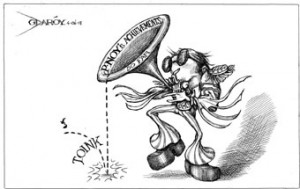IT TOOK some time for the stock market to digest the news, in part because the P74.1-billion share-swap deal between telecommunication giants PLDT and Digitel was conducted in almost complete secrecy, but once the bourse opened for business the day after the deal was announced, it reacted enthusiastically. On the first day, PLDT share prices surged by as much as 17 percent, and those of its main industry rival, Globe Telecoms, rose by as much as 20 percent before settling at around 13 percent.
The main reason for the enthusiasm is clear: The market anticipates the effective end of the price wars that helped widen the base of mobile phone users in the country but considerably narrowed the telecoms’ profit margins.
This hope comes under various guises. A stock market analyst called it “new life.” Said Jose Vistan of AB Capital Securities: “PLDT killed a competitor in a deal that basically injected new life into the Philippine telecom industry.” A Globe internal memo called it “rationality”: “PLDT is seen to carry the cost of bringing rationality back to the market by paying for this acquisition and Globe is seen to benefit from it as profitability remains in a more stable and consolidated market.” And PLDT CEO Manuel V. Pangilinan called it landscape-altering. “Though this initiative alters the country’s telecom landscape, we expect competition within the industry to remain very robust.”
The deal alters the telecom landscape not only because it reduces the number of main players to two (at least before the telecom venture of San Miguel gets off the ground), but also because it raises questions about the long-term viability of the Digitel business model, which depends on aggressive pricing. Sun Cellular, the Digitel brand, became the third major industry player through its price-cutting, and shook up the industry when it started offering so-called unlimited services.
Market players and analysts now expect these innovations to be on the line or, as another internal memo put it, “We might find ourselves competing in a more rational marketplace with better margins as the new opposition could decide to scale back on the unlimited propositions that undermine industry.”
If the public needed a new lesson in the essential difference between market and community, this last excerpt serves as a perfect reminder. The very “propositions” that have widened the customer base and deepened customer loyalty are seen as initiatives that “undermine industry.” The very dynamism in the telecom sector that has led to such labels as “the texting capital of the world” is seen as less than rational. The deal may be good for the market, but is it good for the community at large?
The share-swap arrangement that allows PLDT to assume majority control of Digitel may not be the biggest deal in Philippine corporate history, but in terms of impact on the ordinary citizen it will probably be seen, and felt, that way. The great majority of Filipinos now own or use a mobile phone. Depending on the data used, the total can reach between 70 percent and 90 percent of the population. By one rough estimate, PLDT’s various brands account for some 45 million users, those of Globe Telecoms about 25 million and of Digitel about 15 million. There may be considerable overlap in these totals, because many Filipinos use multiple postpaid lines or prepaid numbers, but no one doubts that the cellular phone has become a vital part of Philippine society. It is nothing less than a component of our quality of life.
Now that PLDT is set to take effective control of Digitel, would the consumer-friendly pricing and “unlimited” bundling of services that have defined the industry, especially in the last two or three years, come to an end? This is the main question that feeds the growing anxiety among the consuming public about the full and real impact of the mega-deal.
If an outraged public can beat back politicians’ attempts to impose a tax on texting, we can expect strong customer resistance if or when the telecom firms push prices (and services) back to what they were a decade ago.
Ultimately, the industry may have to redefine what it means by “rationality” or “efficiency” or “new life,” by including “quality of life” in its calculations


